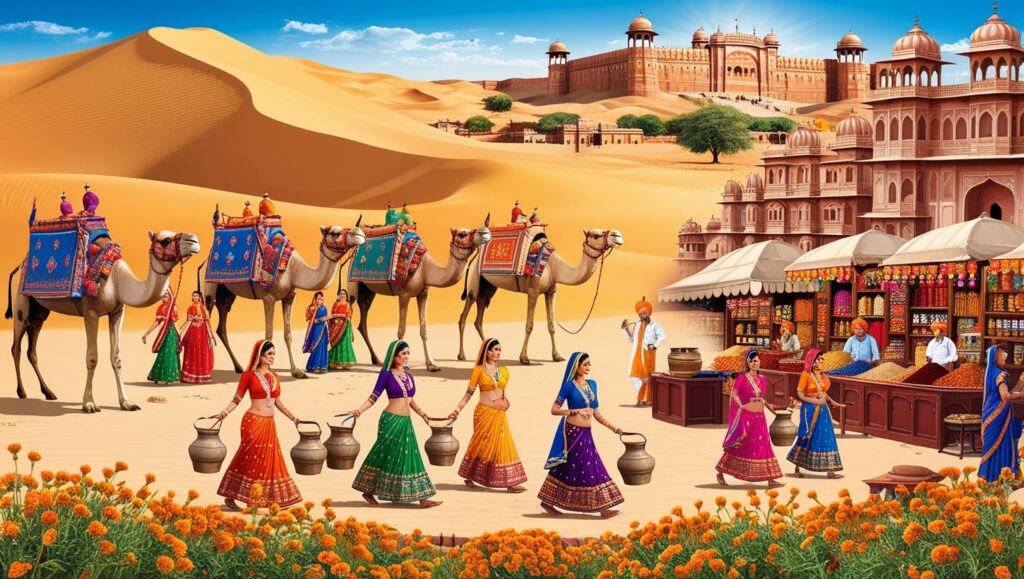Rajasthan, India’s largest state, is renowned for its rich history, vibrant culture, majestic forts, and diverse landscapes. Known as the “Land of Kings,” it offers a blend of heritage, traditions, and scenic beauty, attracting tourists worldwide.
Rajasthan: A Land of Rich Heritage, Geography, and Culture
Rajasthan, the largest state of India, spans an area of 342,239 square kilometers, covering 10.41% of India’s total area. Situated in the northwestern part of the Indian subcontinent, Rajasthan is five times larger than Sri Lanka, three times larger than Czechoslovakia, and twice as large as England, yet slightly smaller than Japan.

Importance of Rajasthan History
Rajasthan boasts a rich and vibrant history, tracing its roots to ancient times when it was known as ‘Rajputana.’ The state was home to the Rajputs, renowned for their bravery and chivalry. In the Rigveda, it is referred to as ‘Brahmavarta,’ and in the Ramayana, as ‘Marukantar.’ The earliest mention of the name ‘Rajasthan’ appears in AD 625 in the inscriptions at Vasantgarh in Sirohi.
The term ‘Rajputana’ was first used by George Thomas in 1800 AD, and later popularized by Colonel James Tod in his book, “Annals and Antiquities of Rajasthan.” On 30th March 1949, four major states—Jaipur, Jodhpur, Jaisalmer, and Bikaner—merged, marking the birth of modern Rajasthan, celebrated as Rajasthan Day.
Geographical Highlights
Rajasthan’s diverse geography includes plains, deserts, and plateaus. The state’s location stretches between latitude 23°3’N to 30°12’N and longitude 69°30’E to 78°17’E. Its maximum length is 826 kilometers, while its breadth spans 869 kilometers.
Key Geographic Features:
- Highest Point: Guru Shikhar (1,722 meters) on Mount Abu.
- Lowest Point: Sambhar Lake, India’s largest inland saltwater lake.
- Rajasthan is often described as a kite-shaped quadrilateral for its unique landform.

Rajasthan’s Rich Cultural Heritage
The culture of Rajasthan is an amalgamation of vibrant traditions, art, and architecture. The state is divided into regions such as Mewar, Marwar, Shekhawati, and Hadoti, each offering unique customs and dialects.
Major Festivals:
- Diwali: Celebrated with grandeur across the state.
- Gangaur: A festival for women, especially popular in Jaipur and Udaipur.
- Teej: Celebrated primarily in Jaipur and Jodhpur.
- Makar Sankranti: Known for its kite festivals in various regions.
- Navratri: Enthusiastically celebrated, especially in Mewar and Shekhawati.
Famous Tourist Destinations
Rajasthan is a haven for history enthusiasts, offering numerous forts, palaces, and natural wonders:
- Jaipur (Pink City): Famous for Amer Fort, Hawa Mahal, City Palace, and Jantar Mantar.
- Udaipur (City of Lakes): Home to Pichola Lake, City Palace, and Sajjangarh Fort.
- Jodhpur (Sun City): Known for Mehrangarh Fort, Jaswant Thada, and Umaid Bhawan Palace.
- Jaisalmer (Golden City): Renowned for Jaisalmer Fort, Sam Sand Dunes, and havelis.
- Bikaner: Notable for Junagarh Fort, Karni Mata Temple, and camel safaris.

Rajasthan’s Contribution to Indian History
Rajasthan played a pivotal role in India’s freedom struggle and remains a symbol of resilience and valiant leadership. Its architectural wonders, such as the forts of Chittorgarh and Kumbhalgarh, are recognized as UNESCO World Heritage Sites.
Notable Facts:
- Gateway to Rajasthan: Bharatpur.
- Famous Mahua Trees: Found in Udaipur and Chittorgarh.
- Major Drought Year: The catastrophic Chhappaniya Akal (1956 AD).
- Monsoon Direction: Advances from southwest to northeast.
Rajasthan: A Blend of History and Modernity
Today, Rajasthan is a globally recognized destination for its royal heritage, majestic forts, and vibrant festivals. From its historic landmarks to its natural wonders, Rajasthan seamlessly blends its glorious past with the aspirations of a modern state. Whether you’re a history buff, a cultural enthusiast, or an adventure seeker, Rajasthan offers an unforgettable journey through India’s rich heritage.

